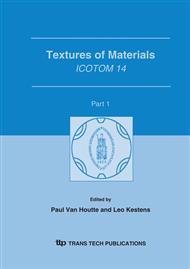p.907
p.913
p.919
p.927
p.937
p.945
p.955
p.965
p.971
A Texture Evolution Study Using the Texture Component Crystal Plasticity FEM
Abstract:
Crystal plasticity FEM simulations of plane strain compression were performed. The Texture Component Crystal Plasticity-FEM was used for the texture mapping. Two different starting textures (random and hot rolling texture) were studied using four different FE meshes and two different sets of boundary conditions. While for the random starting texture the evolution of the texture with deformation was found to be rather similar in all cases studied, the simulations using an experimental hot rolling texture as staring texture are much more sensitive to the boundary conditions and probably also to changes in the mesh geometry.
Info:
Periodical:
Pages:
937-944
Citation:
Online since:
September 2005
Authors:
Price:
Сopyright:
© 2005 Trans Tech Publications Ltd. All Rights Reserved
Share:
Citation:


